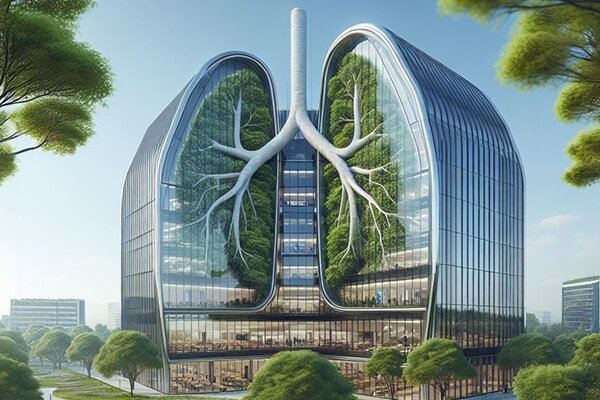- Johnson Controls
- Insights
- The Truth About Indoor Air Quality in Modern Buildings
The Truth About Indoor Air Quality in Modern Buildings
There is a growing conversation in today’s marketplace about the quality of the air we breathe indoors - and for good reason.
As awareness of health, wellbeing and energy efficiency continues to rise, building owners and facilities managers are under increasing pressure to deliver optimal indoor air quality (IAQ). But with so much conflicting information out there, it can be difficult to separate fact from fiction. How do you truly create a healthier indoor environment? What steps are essential to protect occupant wellbeing? And how can you balance these goals with budget constraints and operational efficiency? These are just some of the questions facing those responsible for modern buildings.
In this article, we cut through the noise to address the most common myths and misconceptions about IAQ - and provide the clarity needed to make informed, effective decisions.

Optimal Indoor Air Quality: Separating Fact From Fiction
Optimal indoor air quality (IAQ) is more than just a buzzword; it delivers real, measurable benefits. Research shows that improving IAQ can boost productivity by up to 10%, reduce sick days, and help prevent costly staff turnover. Yet, there is still a great deal of speculation and misinformation about what IAQ truly involves. Let us help clear the air by addressing some of the most common myths.
1. Misconception: Providing indoor air quality comes at a financial cost
It is often assumed that adding filtration will significantly increase energy consumption. However, our research indicates that any increase is minimal. In fact, a recent article, A Triple Win: Achieving Improved Comfort, Indoor Air Quality and Lower Energy Consumption, demonstrates that comfort, IAQ and energy savings can go hand in hand. For example, in a school with one fully occupied classroom and another empty, ASHRAE Guideline 36 recommends optimal air and temperature settings that enhance both indoor air and thermal comfort, while using the least amount of energy. Peer-reviewed studies evaluating this approach (which includes dual maximum VAV control, static pressure reset, and supply air temperature reset) have shown HVAC energy savings averaging up to 31% in some cases.
2. Myth: Outside air is always clean air
The outdoor air used to dilute “stale” indoor air may itself require treatment. Consider the ash and particles present in air from regions affected by wildfires. Less visible pollutants, such as chemicals or fine particulates, may also need to be removed. Moreover, outdoor air is not the only source of clean air. Indoor air can be treated through filtration and disinfection to improve clean air delivery rates.
3. Myth: One technology can guarantee safe, healthy air
Terms like “ventilation”, “filtration”, “disinfection” and “isolation” are often used interchangeably, but each refers to a distinct method of improving air quality. Understanding the differences is essential to ensure your air is being treated effectively.
- Ventilation dilutes indoor air with outdoor air, which may still require filtering or disinfection.
- Filtration removes particles mechanically, but may not eliminate pathogens.
- Disinfection deactivates bacteria and viruses, but does not remove dust or particulates.
- Isolation contains contaminants to prevent their spread, but other areas of the building may still require treatment.
4. Misconception: CO₂ is dangerous
While high concentrations of carbon dioxide can affect respiratory function, CO₂ itself is not toxic at low levels. In fact, it plays a valuable role in clean air strategies. Measuring trace levels of CO₂ helps determine whether ventilation is effective.
5. Misconception: My HVAC system is too old to improve / too new to need improvement
Older systems can often be upgraded cost-effectively with solutions such as zone filtration and disinfection to enhance clean air delivery. Conversely, even the most modern systems require regular monitoring and maintenance to ensure they are performing as intended.
6. Misconception: Setting up your HVAC system for clean air is a one-time task
Maintaining clean air is an ongoing process. Regular monitoring, inspections and servicing are essential to ensure continued performance.
- Review control sequences regularly for overrides or changes.
- Maintain mechanical components and consider more frequent inspections.
- Replace filters according to the recommended schedule.
- Verify the operation of UV-C technology and maintain it as per the manufacturer’s instructions.
- Consider implementing remote monitoring and analytics to detect and resolve issues quickly.
“Buildings are full of potential to make people happier and healthier.”
Katie McGinty, Chief Sustainability Officer, Johnson Controls
In short, it is essential to consider your building systems, equipment, energy usage, infection risk and budget when determining the most effective way to achieve your desired indoor air quality (IAQ).
Johnson Controls offers a comprehensive range of solutions designed to enhance IAQ and improve the overall indoor environment. As you work towards creating a healthier building, we can partner with you to develop a holistic strategy that integrates IAQ, energy management and infection control. This includes a prioritised set of recommendations tailored to your specific goals.
Using this strategy, we collaborate with you to create a plan that aligns with your needs, budget and timeline - ensuring a practical and effective path to cleaner, healthier air.

























.jpg?la=en&h=320&w=720&hash=244C75B74F0F77521D56164450973BCD)






































